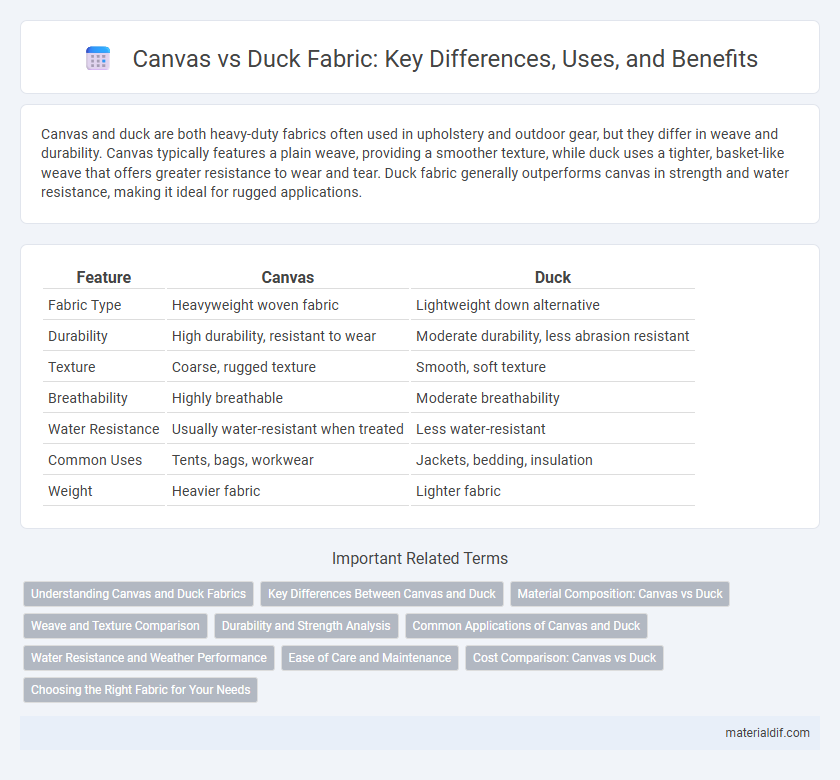Canvas and duck are both heavy-duty fabrics often used in upholstery and outdoor gear, but they differ in weave and durability. Canvas typically features a plain weave, providing a smoother texture, while duck uses a tighter, basket-like weave that offers greater resistance to wear and tear. Duck fabric generally outperforms canvas in strength and water resistance, making it ideal for rugged applications.
Table of Comparison
| Feature | Canvas | Duck |
|---|---|---|
| Fabric Type | Heavyweight woven fabric | Lightweight down alternative |
| Durability | High durability, resistant to wear | Moderate durability, less abrasion resistant |
| Texture | Coarse, rugged texture | Smooth, soft texture |
| Breathability | Highly breathable | Moderate breathability |
| Water Resistance | Usually water-resistant when treated | Less water-resistant |
| Common Uses | Tents, bags, workwear | Jackets, bedding, insulation |
| Weight | Heavier fabric | Lighter fabric |
Understanding Canvas and Duck Fabrics
Canvas fabric is a heavy-duty, plain-woven textile known for its durability and sturdiness, commonly used in making sails, tents, and backpacks due to its resistance to wear and tear. Duck fabric, a variation of canvas, features a tighter weave and smoother texture, providing enhanced strength and water resistance ideal for workwear and upholstery. Both fabrics utilize cotton fibers but differ in weave density, influencing their functional applications and performance in various conditions.
Key Differences Between Canvas and Duck
Canvas fabric is typically plain-woven and heavier, offering a stiff and durable texture ideal for bags, tents, and sails, while duck cloth, a variation of canvas, is tightly woven and smoother, making it more versatile for apparel and upholstery. The primary difference lies in weave style: canvas uses a simple plain weave, whereas duck uses a tighter basket weave, resulting in added strength and a finer finish in duck cloth. Canvas tends to be thicker and coarser, providing high water resistance, while duck is softer and more pliable, favored for workwear and outdoor gear.
Material Composition: Canvas vs Duck
Canvas is typically made from tightly woven cotton or linen fibers, providing a sturdy and breathable fabric ideal for painting and upholstery. Duck fabric, also known as cotton duck, is a heavier, plain-woven cotton textile with a denser fiber structure that offers enhanced durability and water resistance. Both materials share cotton composition, but duck's tighter weave and thicker threads deliver superior strength and abrasion resistance compared to standard canvas.
Weave and Texture Comparison
Canvas fabric features a plain weave that creates a tight, balanced texture with a smooth surface ideal for painting and durable upholstery. Duck fabric utilizes a basket weave pattern, resulting in a thicker, sturdier texture with enhanced strength and resistance to wear. The distinctive weave in duck provides a rugged feel compared to the refined smoothness of canvas, making each suitable for different functional and aesthetic uses.
Durability and Strength Analysis
Canvas fabric is woven from heavy-duty cotton or linen threads, providing exceptional strength and durability ideal for outdoor gear and heavy-use items. Duck fabric, a type of canvas with a tighter weave and heavier weight, offers superior abrasion resistance and tensile strength, making it more robust for industrial and workwear applications. Both materials excel in durability, but duck fabric's denser construction enhances its lifespan under extreme stress and frequent wear.
Common Applications of Canvas and Duck
Canvas is commonly used for artistic projects such as painting, embroidery, and bookbinding due to its tight weave and smooth surface. Duck fabric, often made from heavy, plain-woven cotton, is favored in workwear, outdoor gear, and upholstery because of its durability and water-resistant properties. Both fabrics serve specific functional purposes, with canvas excelling in fine art and crafts while duck is preferred for rugged, utilitarian applications.
Water Resistance and Weather Performance
Canvas fabric typically offers moderate water resistance but can absorb moisture without treatment, making it less ideal for prolonged exposure to wet conditions. Duck fabric, a tightly woven cotton canvas variant, is inherently more durable and, when treated, provides superior water resistance and weather performance for outdoor applications. Its dense weave and ability to repel water effectively protect against harsh weather, making duck the preferred choice for heavy-duty, weather-resistant gear.
Ease of Care and Maintenance
Canvas fabric offers easier care and maintenance due to its plain weave, which resists wrinkles and allows simple spot cleaning. Duck fabric, known for its tighter weave and heavier weight, may require more effort to remove stains and often needs professional cleaning to maintain durability. Both fabrics benefit from air drying and avoiding harsh detergents to prolong fabric life.
Cost Comparison: Canvas vs Duck
Canvas and duck fabrics differ significantly in cost due to variations in weave density and cotton quality; canvas typically costs more because of its tighter weave and smoother finish, making it ideal for art and upholstery. Duck fabric, with its heavier, plain weave and slightly rougher texture, is more budget-friendly and favored for workwear and heavy-duty applications. Choosing between canvas and duck depends on project requirements and budget constraints, as canvas offers higher durability and appearance at a premium price, while duck provides strength and affordability.
Choosing the Right Fabric for Your Needs
Canvas features a tight, plain weave that offers durability and breathability, ideal for upholstery and outdoor gear. Duck fabric, though similar, has a looser weave and slightly heavier weight, providing enhanced strength and water resistance, perfect for workwear and heavy-duty applications. Selecting between canvas and duck depends on your need for breathability versus maximum durability in demanding environments.
Canvas vs Duck Infographic

 materialdif.com
materialdif.com